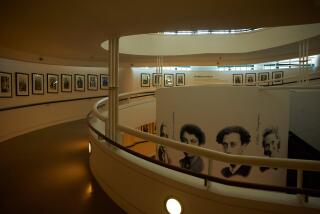Let your conscience be your tour guide
- Share via
WHEN travelers visit great cities for the first time, they usually include art museums on their itineraries -- London’s National Gallery; Washington, D.C.’s Hirshhorn; the Uffizi in Florence, Italy; the Louvre in Paris; or Kunsthistorisches in Vienna, Austria. That’s commendable; these institutions display the highest achievements of art and culture.
Recently, tourists have added another type of museum to their itineraries: places that spotlight the failures of society instead of its achievements. These museums focus on the infamous deeds -- the horrors and the cruelty of humankind -- in the hope that visitors will absorb lessons to help them avoid making similar mistakes. An increasing number of these museums -- called “museums of conscience” -- are being built to convey historic lessons.
In the West African country of Senegal, the Maison des Esclaves, or slave house, of Goree Island has been preserved as a museum of conscience to show the horrendous conditions to which hundreds of thousands of Africans were subjected as they were gathered at the port for delivery to slave ships. Holocaust museums in Washington, D.C., and New York City remind Americans of the killings of millions during World War II.
The Gulag Museum at Perm-36 in Russia preserves one of the Soviet Union’s most infamous camps for political prisoners. The Terezin Memorial in the Czech Republic preserves a death factory operated by minions of the Hitler regime.
A group of human rights organizations called Memoria Abierta, in Buenos Aires, is planning a museum that will recall the kidnap, torture and execution of thousands of Argentine citizens from 1976 to 1983 by the military of that nation.
In the United States, the Japanese American National Museum in Los Angeles tells of the incarceration of Japanese American citizens during World War II. The National Civil Rights Museum in Memphis, Tenn., presents the history of the struggle by black Americans for equality. The Martin Luther King Jr. National Historic Site in Atlanta describes the racial segregation and discrimination that King worked to eradicate in the 1950s and ‘60s.
The Women’s Rights National Historical Park in Seneca Falls, N.Y., depicts the birth of the women’s movement at the site of a historic conference of feminists in 1848. The Lower East Side Tenement Museum of New York City exposes visitors to, among other things, the conditions in which turn-of-the-century immigrants to the United States lived. The Eleanor Roosevelt National Historic Site in Hyde Park, N.Y., relates the first lady’s longtime efforts to fight political, economic and social injustices. There are more examples. Many of the organizations belong to the International Coalition of Historic Site Museums of Conscience, www.sitesofconscience.org, which was created to publicize and promote the museums. The coalition is funded in part by the Rockefeller and Ford foundations and was primarily initiated by New York’s Tenement Museum.
The coalition unites museums in different parts of the world at different stages of development. Each presents history in a light that focuses attention on contemporary issues, fosters dialogue and promotes humanitarian and democratic values.
The issues the facilities are concerned about include continued genocide; the survival of sweatshops; state terrorism, racism and totalitarianism; trafficking in human beings and slavery; the displacement of people; poverty; and the high mortality rate of children in countries at war.
I urge you to visit one or more of the museums of conscience on your next trip.
More to Read
Sign up for The Wild
We’ll help you find the best places to hike, bike and run, as well as the perfect silent spots for meditation and yoga.
You may occasionally receive promotional content from the Los Angeles Times.






